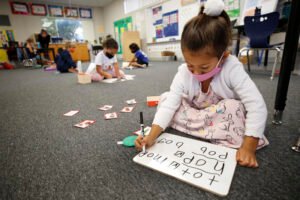Polly Williams desired some control over her oldest daughter’s schooling as Chicago’s public school busing program began to integrate in the late 1970s. Her daughter was assigned to a predominantly Black high school; therefore, she battled to have her transferred to Riverside, a more integrated institution. Asserting that the school’s racial quota had already been reached, administrators rejected the proposal.
Williams was dubbed the “mother of school choice” and “education’s Rosa Parks” after her struggle to prevent such discrimination from continuing began, which ultimately ignited a revolution in education. You are correct in saying that religion, school rivalry, or parental freedom had no bearing on the initial school choice plan. Not happy with where her girls were being bussed, a Black Democratic mother founded it.

After that rejection, Williams decided to run for state legislature. She was eventually partnered with Republican governor of Wisconsin, Tommy Thompson, to get legislation approved that would have allowed low-income students to attend private schools, marking the beginning of the nation’s first school choice program. In order to fill the assembly gallery during the bill’s debate, Williams brought buses full of parents, students, and community organizers. Who “rallied the troops” and “sounded the trumpets” was she? The first school choice program was never passed in 1989, despite numerous attempts to implement it. None of Williams’ four children was able to attend Riverside, by the way.
As states looked for an alternative form of school choice, Fitzpatrick’s book presents a compelling case that the traditional public school as we know it is about to disappear due to the growth of voucher programs that Williams instigated and the explosion of charter schools that she started.
Fitzpatrick writes, “National public education is under threat.” Some pupils have transferred to private schools, charter schools, or homeschooling since the coronavirus pandemic started, and enrolment has dropped significantly in some areas. Adding to the growing absenteeism in public schools across the nation, she says, “other students seem to have dropped out altogether.”Although Fitzpatrick acknowledges that this reformulation of the old public education system is significant and has had a transformative effect, he does not necessarily argue that it is a bad thing.
Given that it is the most significant conflict in education—a fight over what constitutes public education—the fight for school choice has been the most intense in this nation, according to the author. “Since the founding of the nation, controversial debates have been held concerning what kind of education the public should fund, whose values should be taught in schools, and the implications of these issues for democracy and society.”
 Fitzpatrick is thorough in describing the decline of faith in conventional public schools and the emergence of the push to increase public money for privately run institutions, in addition to presenting Williams’ narrative in its entirety for the first time. More than a dozen states have expanded or created voucher programs as a result of the pandemic, she observes, accelerating the growth of educational choice. Subsequent to the U.S. Supreme Court’s decision last year requiring vouchers to be used at both religious and secular schools, more than fifty states now provide publicly supported alternatives to assist parents with the cost of their children’s private education.
Fitzpatrick is thorough in describing the decline of faith in conventional public schools and the emergence of the push to increase public money for privately run institutions, in addition to presenting Williams’ narrative in its entirety for the first time. More than a dozen states have expanded or created voucher programs as a result of the pandemic, she observes, accelerating the growth of educational choice. Subsequent to the U.S. Supreme Court’s decision last year requiring vouchers to be used at both religious and secular schools, more than fifty states now provide publicly supported alternatives to assist parents with the cost of their children’s private education.
These states do not include Colorado, though. It’s possible that after the Supreme Court decision, Colorado voters and courts would no longer uphold voucher programs that were established at the local and state levels. On the other hand, Colorado was among the first states to implement virtual learning. This is one of the highest percentages in the nation: according to the Colorado Department of Education, in the 2022–2023 school year, 264 charter schools were attended by 14.4% of the 883,264 pupils enrolled in Colorado’s public school system.
It raises the question, in the end, of what really is universal education? Should a youngster attend a private school, charter school, magnet school, or receive their education at home, is the cost of education sponsored by taxes? Or does it serve as a place where people from various walks of life and socioeconomic backgrounds come together to attend school? Can Americans choose exactly what they want from an education for their children at a public school, or are public schools just a collection of options?
Answering the question of whether public schools are dying or are simply redefining themselves requires returning to the original intentions of the “mother of school choice.” Giving Black working-class and low-income families in Milwaukee more control over their lives was Williams’ particular goal. In the end, she concluded that making education the priority was crucial.
Fitzpatrick notes that the subject in question was in favor of school vouchers intended for the impoverished rather than for wealthy families. A social justice mission was Williams’s. Her goal during her ten years in the state Assembly was to reverse Milwaukee Public Schools’ long history of underserving Black children by granting the Black community more authority over the school system.
Fitzpatrick recalls that during her public opposition to legislation in 2011 to expand the voucher program beyond low-income families, she eventually drove the Wisconsin school-choice movement insane by claiming it would be a thinly veiled gift to the wealthy who already send their children to private schools.
Today, the key question is whether the revolution she sparked improved education for all or only for a select few under our “education for all” system. There’s no denying that many charter schools and unquestionably many private schools outperform conventional public schools. Nevertheless, that doesn’t absolve us. For the 90% of American students who still attend traditional public schools—including the 23,000 in Colorado Springs and the 89,000 in Denver—we still need to give them better quality instruction.
It would be unrealistic to think that offering parents an option for schools will address the issue of our subpar public education system. Multiple school options are beneficial. Attending a top-notch school should be accessible to all.
“It was never supposed to get this big,” Williams said, expressing alarm about how much her state’s voucher programme had grown beyond its original goal of providing equitable opportunities for underprivileged pupils as she neared 60 years old.







